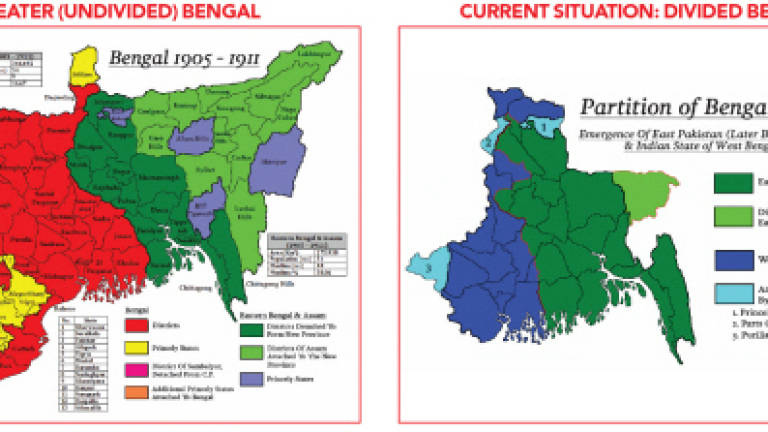The Bengali homeland(s)

THE British colonial administration recognised the basic skill sets and capabilities of the Bengali community. Particularly their penchant for acquiring better education, logical mind, competence in mathematics and accounting, plus marginally better ability to speak and (especially) write grammatically correct English.
The British administrative system was driven by commercial interests. In that era these interests primarily focused on commodities and cash crops including food grains, tea, jute, indigo (neel) plantations, mines and textiles.
Educated (high school/ intermediate pass and graduate) Bengalis were increasingly hired to execute the:
a) basic government administrative process in Writers Building (Calcutta) as well as the district and sub-divisional offices;
b) commercial process in merchant offices, indigo and tea plantations, various mills, mines and distribution offices;
c) daily office/administrative process in the railways, customs, licence measurers, postmaster and sub-postmaster roles.
d) Consequently, the "Babu Culture" was born.
They were given the status (or perceived status) of white-collar office staff: LD (lower-division) clerks, UD (upper division) clerks and the lower rungs of the supervisory positions.
▶ They actually ran the business and administrative process while the firangi (mat salleh/gwei lo) bosses spent easier days playing tennis or golf and downing chota pegs in their clubs. Besides spawning legitimate and illegitimate children later identified as Anglo-Indians.
▶ Later sub-segments are also referred to colloquially as Kasundhi Joes and Chutney Mary(s).
Due to better education, Bengalis were also among the earliest Indian communities to come into the medical profession: largely as LMPs (licensed medical practitioners), compounders and medical/nursing assistants. Besides being in demand as primary school teachers, divisional clerks and accounting clerks, as the townships, railway and commercial enterprise colonies were established.
The ambit of the erstwhile colonial Bengal Presidency spanned across the geographic areas of (undivided) Bengal, Purnea-region/north-eastern and south Bihar, eastern Uttar Pradesh, parts of lower and central Assam (south of the Brahmaputra river) plus the Chittagong Hill Tracts bordering Myanmar (Burma)**.
In Eastern India, the Bengali diaspora settled across this wider geographic area well beyond the original (undivided) Bengal state boundaries. [See Greater (undivided) Bengal.]
This huge Bengal state has, since 1947, been divided across two different countries: West Bengal (in India) and Bangladesh (earlier East Pakistan 1947-1971).
▶ In India, other portions of the Bengal Presidency have been aligned into Assam, Tripura, Bihar/Jharkhand, Orissa and Uttar Pradesh.
▶ Part of South Eastern Bengal fell into Burma (now Myanmar). The ancestors of most Malaysian Bengalis emigrated from pre-partition, undivided Bengal in eastern India, while still under colonial rule. While conducting the interviews one noted:
a) A higher percentage of ancestors are East-Bengali Bangals hailing from Brahmanbaria, Comilla, Mymensingh, Manikganj, Rajsahi, Chittagong, Cox-Bazar and Barisal during the colonial period.
b) Besides Ghatis from Calcutta, central West Bengal and lower-Assam.
c) Nowadays, most expatriate Bengali professionals in Malaysia (and Singapore) hail from Greater-Calcutta (Kolkata), Delhi and Bombay and some from Uttar Pradesh.
In colloquial Bengali, folks hailing from East Bengal are referred to as "Bangal" while those from West Bengal are termed "Ghati". Families living in regions west of the Bengal state-border, especially in Bihar, Uttar Pradesh and North-Western India and Central Provinces (now Madhya Pradesh and Chattisgarh) were called "paschimer probasi (expatriate) Bangali".
** Masonic brethren might be interested to learn that the ambit of the Bengal District in Freemasonry spanned across this region, registering member lodges from as wide as Kanpur (in Uttar Pradesh), Nepal, East Pakistan (now Bangladesh), Assam/Dooars region and Rangoon (besides West Bengal).
▶ The Kathmandu-Nepal chapter was raised in 1988-89 in a chapter in Calcutta while this writer was the ruling MEZ.
▶ Earlier, on rare occasions during his junior school days, while accompanying his late father on district visits, he noted a peculiar facet. Many of the Tylers were elderly Bengali Babus. Recruited into the craft more for their ability to communicate the reports in fluent English and give the correct knocks, rather than preventing the entry of cowans.
Which local would even dare to meander near the rumah-hanto (bhoot-ghar) ...!